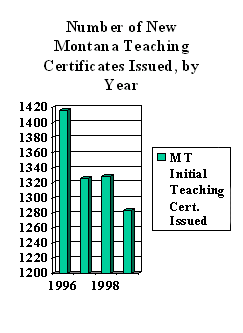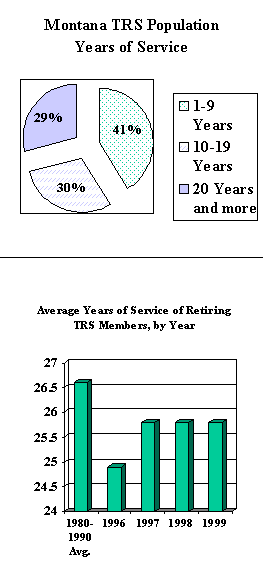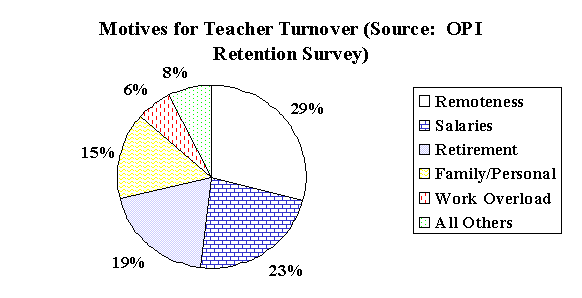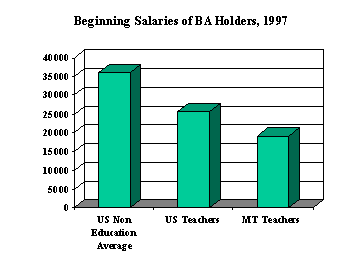
EXECUTIVE SUMMARY
The Governor's Task Force on Teacher Shortage/Salaries has worked since April to identify causes and possible solutions for Montana's current and projected teacher shortage. It is the task force's conclusion that a teacher shortage problem does, in fact, exist in Montana and that several factors have led to this current status within the teaching profession. These include:
With these factors in mind, the task force now issues a series of state policy recommendations to begin to address Montana's teacher shortage problem. The task force recommends that the State of Montana:
With these policies in place, the task force believes that positive changes can be accomplished for Montana's schools, communities, and most importantly, children.
The task force is pleased that Governor Racicot is willing to focus needed attention on this complex problem and look forward to his support of some or all of these proposals.
INTRODUCTION
In April of 2000, Governor Racicot appointed a twelve-member task force to investigate the related problems of teacher shortages and teacher salaries in Montana. In his letter of appointment to task force members, Governor Racicot charged the group to study the causes of Montana's teacher shortage problems and suggest solutions which can be incorporated into policy changes during next year's legislative session. Comprised of teachers and representatives from a variety of sectors in Montana, the Governor's Task Force on Teacher Shortages/Salaries met three times in the past five months to fulfill this directive. The task force is now proud to submit this final report to the Governor to serve as an in-depth discussion of the problem of teacher shortages in Montana and to provide recommendations that will directly address the goal of ensuring that all Montana children have access to professional, high quality teachers in their classrooms.
TEACHER SHORTAGE IN MONTANA: DEFINING THE PROBLEM
Teacher shortages have been predicted to be a major issue facing the nation for a number of years now.  According to Education Week's comprehensive report on the nation's teacher labor market, Quality Counts 2000, over two million new teachers will be needed in America's schools over the course of the next decade. While Montana was originally thought to be exempt from a great deal of this demand, the fact that other states, like Nevada, Oregon, Washington, and California, are recruiting our teachers to solve their shortage problems is having an extremely adverse impact on filling teaching vacancies in many areas of Montana.
According to Education Week's comprehensive report on the nation's teacher labor market, Quality Counts 2000, over two million new teachers will be needed in America's schools over the course of the next decade. While Montana was originally thought to be exempt from a great deal of this demand, the fact that other states, like Nevada, Oregon, Washington, and California, are recruiting our teachers to solve their shortage problems is having an extremely adverse impact on filling teaching vacancies in many areas of Montana.
According to recent survey statistics from the Office of Public Instruction (OPI), of the nearly 1300 newly certified teachers in 1999, nearly one-third have taken jobs out of state, while almost another third will not enter the teaching profession. At the University of Montana, 75% of education program graduates this past year are leaving Montana to take teaching positions out of state.
This comes at a time when it is projected that 1100 certified staff positions in Montana will need to be filled within the next two years. Depending on the number of teachers who retire or leave teaching during this same time, the number could easily jump to over 1600, meaning that Montana schools will likely be hundreds of teachers short of filling needed positions in the near future.
 This latter scenario becomes more plausible when considering the demographics of Montana's current teaching population. According to Teacher Retirement System data, 29% of Montana's teaching workforce will be eligible to retire with full retirement benefits in the next five years, and in fact, a majority of those eligible to retire are expected to do so considering Montana's historical retirement trends (see chart below).
This latter scenario becomes more plausible when considering the demographics of Montana's current teaching population. According to Teacher Retirement System data, 29% of Montana's teaching workforce will be eligible to retire with full retirement benefits in the next five years, and in fact, a majority of those eligible to retire are expected to do so considering Montana's historical retirement trends (see chart below).
As a result of these trends superintendents throughout Montana have expressed difficulty in finding new teachers to fill specific, certified positions. Last year, 104 districts expressed difficulty in hiring music educators; 86 had difficulty in hiring special education teachers; and 67 had difficulty in hiring foreign language teachers. Similar shortages were pronounced in the fields of library, speech pathology, mathematics, science, vocational education, and art. Even elementary education positions, often thought to have an abundance of new candidates, were reported as being difficult to fill in 40 Montana districts.
In some districts, these shortages have meant the reduction or elimination of educational programs such as foreign language, art, vocational education, and music. While some courses in these areas are not specifically required by state accreditation, a lack of qualified personnel to teach these subjects has meant that districts have little possibility in offering these programs or assuring that students have access to qualified teaching personnel. Taken altogether, many learning opportunities for young Montanans are beginning to be diminished by an inability to recruit and retain educators in Montana schools.
After concluding that a problem does, in fact, exist in Montana related to the hiring and retention of educators, the task force sought to identify several factors that are specifically affecting teacher recruitment and retention in the state. Based on a review of state and national data and information, the task force determined the following causes as being significantly related, if not direct causes, of teacher shortages in the state:

 These findings are consistent with survey information compiled by OPI, which suggest that the top five reasons teachers are leaving the profession in Montana are: 1) remoteness; 2) salary; 3) retirement or change of careers; 4) family or personal reasons; 5) work overload and/or disillusionment with teaching. Please see the chart above for the specific results of this survey of Montana superintendents.
These findings are consistent with survey information compiled by OPI, which suggest that the top five reasons teachers are leaving the profession in Montana are: 1) remoteness; 2) salary; 3) retirement or change of careers; 4) family or personal reasons; 5) work overload and/or disillusionment with teaching. Please see the chart above for the specific results of this survey of Montana superintendents.
Below is a brief summary of each of the motives highlighted by the task force.
Salary
Salary levels are always important factors in individual decisions to pursue any profession or career. Especially in recruiting new employees, salary differentials can substantially influence career choices. In Montana, average teaching salaries have fallen below those found in nearby states, including Idaho, Wyoming, Oregon, Washington, and Utah. The average beginning teaching salary is also lower in Montana than these same states, except for Idaho. According to national rankings of average teaching salaries, Montana's rank has fallen from 28th in 1980 to 47th in 2000. In addition, beginning teaching salaries continue to lag behind the average salaries of other occupations requiring similar levels of education, as the chart above indicates.
Recruitment efforts of other states and districts
According to statistics from the University of Montana School of Education, in 1995 79% of UM teacher education graduates accepted positions in Montana, while in 2000 the percentage has dropped to 25%. In addition, out-of-state recruiters have greatly outnumbered Montana districts at recent career fairs at both the University of Montana and Montana State University. Districts in other states have also been able to offer Montana students a variety of programs and incentives in return for their commitment to teach outside of Montana. Among these include, signing bonuses as large as $10,000, loan forgiveness, mentoring programs, and affordable housing options.
Lack of Induction and Mentoring Programs
Recent evidence from the widely recognized Baccalaureate and Beyond data collection found that teachers who do not participate in mentoring or induction programs are nearly twice as likely to leave the profession after their first three years of teaching. While data do not exist to show the attrition rate of Montana teachers, anecdotal evidence posed by the Task Force suggests that many teachers would not leave the profession if they were better supported during their first years of teaching. Such a finding is consistent with other national research concluding that mentoring has a profound impact on both teacher quality and satisfaction.
Retirement and Post-Retirement Employment Options
As stated earlier in this report, the average retirement age of teachers in Montana has been declining in recent years. Teachers are leaving the profession earlier than ever before, meaning that more teachers are now required to fill open positions. One reason that teachers and administrators exercise their option of retiring after only 25 years of service is that they can begin new careers at a relatively young age while simultaneously collecting retirement benefits. District retirement incentives have also been commonplace in recent years further exacerbating the need for new teachers. In addition, some teachers move to other states to continue their professions in education, but while also drawing their Montana retirement. Such options allow teachers and administrators to earn far more than they would by remaining in a Montana school following their 25th year of service.
Immense workloads and numerous preparations due to small school settings
A recent survey of rural teaching position openings in Montana suggest several characteristics that have become commonplace in the expectations for beginning teachers in Montana. These include: 6-7 class preparations, often in courses other than chief certification area; lunch, study hall, and other student supervision responsibilities; extra-curricular duties, such as coaching or organization advising; and limited contact with other teaching professionals.
Remoteness of available openings
As already indicated, remoteness is a commonly cited reason that Montana teachers leave the profession. This stems from Montana's obvious geographic characteristics, which result in teachers being hundreds of miles away from professional and personal community and resources crucial to professional growth and satisfaction.
Working conditions and other factors affecting daily teaching
Some teachers who leave the profession cite reasons such as lack of administrative support and disciplinary problems for their decision. Others point out problems with parents, community, extra-curricular obligations, and school facilities that become burdensome to their ability to teach. While often these factors are difficult to classify, they do provide some insight into the nature of career decisions in education. Several task force members provided testimony that for many teachers, the ability to educate without unnecessary interference or external burdens was the critical determinant in their decision to either remain in or leave the profession. Finally, task force members discussed the practice of districts opting not to renew contracts of teachers who are scheduled to receive tenure protection following their third contracted year. According to several task force members, such a practice has helped lead to high attrition rates amongst Montana teaching professionals.
PROPOSING A SOLUTION
Prior to suggesting a variety of proposals, the task force first wanted to express their belief that K-12 school funding must be a state priority if districts are expected to recruit and retain quality teachers. In addition, the task force also expressed a desire that the state allows districts more flexibility with existing funding sources so that district options to address local problems related to teacher shortages would be maximized. In order to emphasize these points, the task force adopted the following policy statement:
The Governor's Task Force on Teacher Shortage/Teacher Salaries believes that without increases in Montana's basic district and per-pupil entitlements, efforts to enhance teacher recruitment, retention, and salaries in Montana will not be successful. Therefore, the task force recommends that prior to addressing new proposals to enhance educator salaries and working conditions in Montana, increases in state funding for Montana's school entitlements be assured.
In addition, it is the consensus of the task force that the state of Montana pursue state and local measures which will allow local Montana school districts greater flexibility in utilizing existing revenue sources and funds.
Having expressed their desire for these fundamental requisites, the Governor's Task Force on Teacher Shortage/Teacher Salaries developed a series of specific proposals intended to mitigate the impact of teacher shortages in Montana. All of the proposals target specific needs that are believed to directly impact Montana's ability to recruit and retain quality educators. While none of the proposed policies represent a panacea, taken together, they could present a formidable force in preventing future teacher shortages in the state.
The proposals of the task force are listed below in priority order, along with short summaries of the task force's rationale and related discussions.
1) State funded, $500 salary increases for all teachers in Montana and legislature-funded study of existing school finance formula
The proposal to increase every Montana teacher's salary by $500 was developed with the intent of directly addressing the problem of teaching salaries in Montana. Several task force members clearly anticipated that such an effort would retain existing teachers in the classroom, improve teacher morale, and augment the ability of districts to attract new teachers. According to task force members, the need for such an unprecedented effort is clearly demonstrated by the extremely low salaries offered in many Montana school districts, and by the fact that because of declining enrollments and capped spending, some districts have been unable to offer significant teaching salary increases for several years. Therefore, the task force also recommends that the $500 per teacher increases not be calculated as a part of district spending in relation to Montana's legally defined spending caps. Based on projections from the task force, such a policy would cost the state approximately $12 million during the next biennium.
While support for this proposal was not unanimous, its rationale was clearly appealing to members of the task force due to a large degree of frustration over the difficulty in addressing teacher salaries under Montana's existing school finance formula. This sentiment is reflected by a directly related recommendation that, funding be provided by the Legislature to study and improve Montana's existing school finance formula which takes into account the necessity of providing for competitive salaries for educators.
Also reflective of this frustration was the widespread notion amongst task force members that Montana should move toward a statewide salary schedule. However, almost all task force members thought that such a recommendation would be unrealistic given Montana's current fiscal conditions and the difficulty in achieving a uniform pay scale agreeable to all Montana school districts.
2) State funded mentoring/induction programs
Based partially on the fact that in Montana, like other places in the nation, many teachers leave the profession during their first five years of employment, the task force concluded that mentoring and induction programs might significantly augment the number of educators who teach in the state. Therefore, the task force recommends that the state create and fund a mentoring program which provides districts with the opportunity to better retain new personnel, while simultaneously improving new teacher quality. The task force recommends that such a program possess the following characteristics:
In discussing the need for mentoring programs, the task force also discussed the need for changes in schools of education in general. More pre-service experience in the classroom and the reexamination of Ateaching lab schools@ were both explored by various task force members as means to ensure that new teachers were better prepared and better able to handle classroom teaching, although they were not included in these task force recommendations.
3) Targeted scholarship and loan repayment plans
One of the chief refrains from almost all members of the task force was that Montana must find a way to keep Montana teacher education program graduates and current teachers in the state, especially those in high demand, low supply certification fields such as special education, speech pathology, and music education.
After investigating a variety of strategies in other states that might accomplish this goal, the task force recommends a scholarship and loan forgiveness strategy aimed at the state's most significant shortage areas. The task force recommends that this strategy include the following components:
a) A scholarship program for juniors, seniors, and graduate students at Montana University System schools of education which is structured based on the following guidelines:
b) A loan forgiveness program targeted toward teachers who agree to teach in high demand/low supply areas (as defined both in terms of geographic areas and certification/endorsement areas) which is established according to the following guidelines:
4) National Board Certification professional stipends
After reviewing a variety of policies from other states which provide educators with additional income and salary incentives, several task force members quickly noted the widespread utilization of professional stipends for National Board Certified teachers. Indeed, 27 other states offer professional stipend programs with stipends ranging in value from $1000 in Kansas to 12% of base salary in North Carolina. These policies provide teachers who have successfully completed the arduous and well-established National Board Certification process with salary stipends that honor the certification's signal of quality teaching. Task force members not only considered this a means to improving teacher salaries in an accountable manner, but also were attracted to the professional development and teacher quality outcomes, which have been lauded by teachers who undergo the National Board Certification process.
For these reasons the task force recommends that $3000 annual stipends be provided to teachers who successfully earn National Board Certification and continue teaching in K-12 classrooms in the state. These stipends will be granted for the life of the certificate, which is 10 years. To accentuate the positive professional development and teacher leadership that comes through the National Board Certification process, the task force also recommends that districts consider mentoring and other professional development related duties for National Board Certified teachers who receive the state incentive payment. The expected cost of providing these stipends to Montana teachers during the 2003 biennium is $150,000.
5) Increase retirement benefit multiplier to 2% for TRS members who retire with 30 or more years of service
Recognizing that one of the chief factors in teacher turnover in Montana continues to be high numbers of retirements, the task force wanted to consider potential retirement law changes which might retain Montana teachers in the classroom beyond the typical 25.8 years of service. As was discussed earlier, many Montana administrators and educators leave the state once they have spent 25 years in the Montana Teacher Retirement System and become eligible for a full retirement benefit. These educators often leave Montana and take similar positions in schools and districts out of state to further augment their retirement income. The task force concluded that any efforts to encourage these educators to remain in the state would be helpful in keeping quality Montana teachers in the classroom.
After discussing several policy proposals to achieve this goal, the task force recommends that Montana adopt a 2.0% benefit multiplier in the TRS benefit formula for members with 30 years of service. In addition, the task force recommends that the multiplier be funded through local retirement levies that already exist to provide for teacher retirement throughout the state, or by direct state appropriations from the general fund. If not funded through the general fund, mill levy increases would be necessary in many Montana counties. If the funding is to come through the state's general fund, the biennial impact during the 2003 biennium is expected to be $18 million.
According to task force members, such a policy will: encourage teachers to remain in Montana school district teaching positions beyond 25 years; reward all teachers who agree to extend their careers beyond 30 years; increase the number of available classroom teachers and administrators; and provide a superior level of replacement income in retirement. According to statistics provided by TRS, a teacher in Montana who extended their career to 30 years to be eligible for the 2.0% benefit multiplier could enhance their monthly retirement benefit by approximately ten percent. Such an enhancement, in the minds of task force members, will certainly provide a strong incentive for experienced teachers to remain in Montana classrooms and districts.
6) State tax credit for teacher transfers across districts
Several task force members were concerned that uneven salary levels in the state greatly contribute to teacher shortages in many districts. These members expressed their belief that many teachers never consider applying for positions in other Montana communities because their years of service will not be fully honored, and they will likely earn less if hired. As a result, the distribution of Montana teachers continues to favor larger and better paying districts.
To limit this factor in educator decisions to relocate, the task force recommends that a state tax credit be instituted for those teachers who lose salary as a result of a decision to relocate. Such a tax credit will accrue to those teachers who demonstrate a loss of salary due to relocations. The tax credit will be good up to the total amount of demonstrated salary loss reaching a maximum of the total state income taxes paid by an individual teacher.
Because the potential utilization of such a benefit is unknown, the fiscal impacts of this recommendation on the state's general fund collections are difficult to determine and no estimate can be provided at this time.
Task force members were nearly unanimous in their decision to attach their lowest priority to this recommendation.
General recommendations to districts to improve recruitment and working conditions of teachers
In addition to the six state policy proposals listed above, the task force also wanted to utilize their unique opportunity to encourage districts to consider a series of suggestions that might assist in the recruitment and retention of educators. Therefore, the task force recommends a series of practices that can be broken down into two main categories:
1) Increasing access to district and community resources and opportunities
By attempting to develop partnerships to offer these types of benefits to new teachers, it is the task force's belief that districts can greatly enhance their ability to attract and retain teachers in their communities, regardless of their geographic location.
CONCLUSION
After five months of study and review of Montana's teacher supply and demand, the Governor's Task Force on Teacher Shortages/Teacher Salaries concludes that Montana is indeed heading for a substantial teacher shortage. However, the task force believes that solutions to the projected problem do exist, and that when taken together, these solutions can provide Montana students and families with the assurance that they will be served by competent and professional classroom teachers, no matter where they reside in this state.
| TERRY BEAVER Educator Helena ERIK BURKE Office of the Governor Helena BILL COOPER Office of Public Instruction Helena ERIC FEAVER MEA-MFT Helena DIANE FLADMO Board of Public Education Glendive LORAN FRAZIER School Administrators of Montana Helena |
LANCE MELTON Montana School Boards Association Helena ALAN OLSON Roundup School District Board of Trustees Roundup DAVE PUYEAR Montana Rural Education Association Helena CATHY SESSIONS Educator Choteau DEBBIE SHEA State Senator Butte TOM ZOOK State Representative Miles City | |